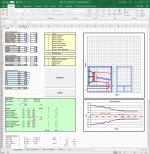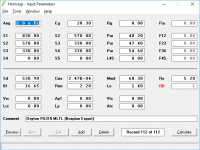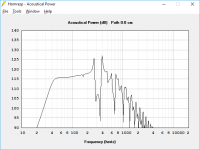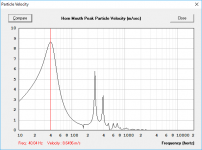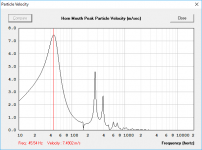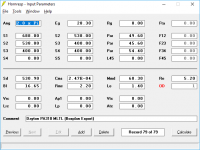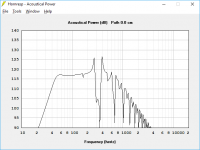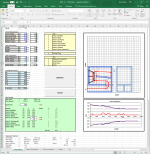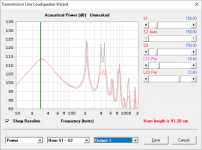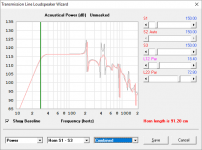For this potential build, I'm looking at using the spare PA310 I now have on hand to build a "small" bass unit that can do 42 Hz and can be carried with one hand (with a handle mounted on top). I basically used the same spreadsheet that I used to design the "Boom Unit", modified to include a center brace for the vent. The sims look pretty decent. I'm wondering if I should go with a higher Fb for a little more midband efficiency, but I can see this just being placed in a corner and covering 40 Hz to 120 Hz. The sim suggests that Xmax will be exceeded just above 100W, but my experience with the PA310 suggests that it can take a little more than that and not sound too bad. Particle velocity at the vent seems pretty low at 100W and surprisingly modeling this alignment as a vented box produces very similar results at low frequencies.
Thoughts? I may end up committing this to wood this weekend. Let's see if I can screw up with that build as much as I did building the "Boom Unit"...
Thoughts? I may end up committing this to wood this weekend. Let's see if I can screw up with that build as much as I did building the "Boom Unit"...
Attachments
that looks really good - can you get any significant punch gain in the same 73 liters (did I get that wrong?) without losing much low end?
here's one with a small straight vent https://i.imgur.com/39zYzwg.jpg
here's one with a small straight vent https://i.imgur.com/39zYzwg.jpg
Last edited:
that looks really good - can you get any significant punch gain in the same 73 liters (did I get that wrong?) without losing much low end?
here's one with a small straight vent https://i.imgur.com/39zYzwg.jpg
Net box size works out to 75.1 liters. The HornResp sim suggests a slightly smaller volume.
Interestingly enough, the peak linear output, according to the sim, will only be slightly lower than the TH I built for that driver. It will require more power to get there though, and there's no "natural cooling" of the motor as one would get with a TH design where the driver's butt is hanging out in the mouth of the TH. OTOH, it won't have the TH's disgusting response above 120 Hz
I'm really tempted to build it to see if the response matches the sim. To answer your question, it can be given more "punch" in the same volume, basically by using larger vents, but the low end will suffer, the gain in sensitivity will be about one or two dB, but power-handling will increase, so peak output will also go up a bit. As it is, I'm struggling to convince myself to design a bass unit with an Fb that's above 42 Hz, considering what modern dance music is like
To answer your question, it can be given more "punch" in the same volume, basically by using larger vents, but the low end will suffer, the gain in sensitivity will be about one or two dB, but power-handling will increase, so peak output will also go up a bit.
And here we go - this is a version with larger vents that tunes the enclosure to 47.5 Hz. Passband output has gone up by around 2dB it seems. External box size remains the same. Particle velocity at the vent remains low.
Attachments
would there be tall versions of these PA310-8 alignments with significant box depth reduction?
Unlikely. The box's dimensions are a significant part of the alignment. Shallower box = shorter port = higher Fb.
BTW, I was all set to build the ~40 Hz version of this box today (my first build since my minor stroke early this month), and ended up being tied up with other issues. I also have another idea I want to explore about designing a vented system where a "stub" chamber on the vent can help to reduce port resonance effects (all simmed via Hornresp), and I may end up building that first...
I also have another idea I want to explore about designing a vented system where a "stub" chamber on the vent can help to reduce port resonance effects (all simmed via Hornresp), and I may end up building that first...
Preliminary results look promising - looks like 6-12dB of suppression around 400 Hz by adding a stub to the vent that's a few inches long, and lightly stuffed. Dealing with that 200 Hz peak is proving to be more difficult though.
Attachments
If it were me, I'd go for extension over a few dB more in the passband. That driver is a good value, but with the limited Xmax, I feel a fuller sound will be more beneficial in a vented alignment.
Yeah, I find it hard to design a bass box that has an Fb that's higher than 40 Hz. I might compromise with a 42 Hz Fb for this design, and just accept that peak SPL in the passband might be limited by one or two dB. Or just use dynamic EQ/limiting to limit input to the system around the frequency when in-band excursion may become a problem.
I'd go for a mid 30s tuning.
I have to wonder how much you'd save in box size with passive radiator(s) and
if it would be better sounding eliminating the upper band response issues.
I'm thinking a pair of 12" or 15" PRs.
Mid 30's would be way too low for this driver. It does not like going that low at all, and the passband will dip too much. 40 Hz is about as low as I'd aim for. Concerning the response issues at higher frequencies, for light PA bass bin duty, it won't be carrying much above 100 Hz anyway, so all the upper band response issues will be doing is amplifying any distortion generated by the system.
At some point I'm going to find myself dabbling with PRs, but it will likely be one of those compliance-assisted designs, rather than a basic PR alignment. I've always wanted to try one of those. I need to find a source for driver cones and surrounds though. Not something that Parts Express really keeps in supply...
Preliminary results look promising - looks like 6-12dB of suppression around 400 Hz by adding a stub to the vent that's a few inches long, and lightly stuffed. Dealing with that 200 Hz peak is proving to be more difficult though.
Do you plan on running DSP with your amp? What frequency will you be low passing at? This sim looked good.
Do you plan on running DSP with your amp? What frequency will you be low passing at? This sim looked good.
Primarily this build is likely going to be used a "reference" build to compare the others to in terms of response and output. I already have the driver on hand (rescued from my POC3 TH when I upgraded it) and I have spawn-of-the-devil MDF on hand which I'm certainly not going to use for any serious work. If I was going to use this build as a bass bin for a mini PA, I'd low-pass around 120 Hz or so, based on the capabilities of the speakers I'm using for the tops. The form-factor (14" wide) should make it easy enough to carry, by just placing one embedded handle at the top.
My mobile mini-PA system gets its power from the Alpine PDX amps in my car - they use plugs for connecting the speakers, so it only takes a few minutes to set things up. For other uses I've got two iNuke 3000 DSP amps I can use (and yes, I've used their DSP features to prevent over-excursion and the like), but they're in need of repair at the moment. Which reminds me - I need to get off my lazy a$$ and ship them for repair....
Primarily this build is likely going to be used a "reference" build to compare the others to in terms of response and output. I already have the driver on hand (rescued from my POC3 TH when I upgraded it) and I have spawn-of-the-devil MDF on hand which I'm certainly not going to use for any serious work. If I was going to use this build as a bass bin for a mini PA, I'd low-pass around 120 Hz or so, based on the capabilities of the speakers I'm using for the tops. The form-factor (14" wide) should make it easy enough to carry, by just placing one embedded handle at the top.
My mobile mini-PA system gets its power from the Alpine PDX amps in my car - they use plugs for connecting the speakers, so it only takes a few minutes to set things up. For other uses I've got two iNuke 3000 DSP amps I can use (and yes, I've used their DSP features to prevent over-excursion and the like), but they're in need of repair at the moment. Which reminds me - I need to get off my lazy a$$ and ship them for repair....
I was wondering if you would be using DSP, because the peak you had in your sim at 200Hz shouldn't be too bad to reduce enough to not effect the lowpass crossover.
You say the 3000s need repair, may I ask what happened? I have a 1000dsp and 3000dsp that I use for my two-ways. Just wondering if it is something I should watch for.
Mid 30's would be way too low for this driver. It does not like going that low at all, and the passband will dip too much. 40 Hz is about as low as I'd aim for. Concerning the response issues at higher frequencies, for light PA bass bin duty, it won't be carrying much above 100 Hz anyway, so all the upper band response issues will be doing is amplifying any distortion generated by the system.
At some point I'm going to find myself dabbling with PRs, but it will likely be one of those compliance-assisted designs, rather than a basic PR alignment. I've always wanted to try one of those. I need to find a source for driver cones and surrounds though. Not something that Parts Express really keeps in supply...
I remember your interest in those tricky PR designs on the Bass List - that was a long time ago.
You say the 3000s need repair, may I ask what happened? I have a 1000dsp and 3000dsp that I use for my two-ways. Just wondering if it is something I should watch for.
I'm not sure. They simply stopped working properly. I wasn't even playing them anywhere near peak level. For the first one, the left channel failed and the amp fails to get past POST. For the other, it will play for awhile and then descend into distortion, suggesting a problem with its power supply. It has kind of turned me off of the iNuke series, though users have reported no problems with their iNuke amps.
At some point I'm going to find myself dabbling with PRs, but it will likely be one of those compliance-assisted designs, rather than a basic PR alignment. I've always wanted to try one of those. I need to find a source for driver cones and surrounds though. Not something that Parts Express really keeps in supply...
Speaker Passive Radiator Replacement Kit, 12" Speakers, PASK-12
That there defines why I find it so hard to start on a project like this. Once the cost of the PRs is included in the design work, I tend to drop the design in favour of others that can produce similar performance at lower cost.
They do seem over priced, could just buy repacement foam on ebay and use a masonite
disc for the "cone". I'm convinced that there is a cost effective way to do a high output PR.
This is a better price especially if they do combined shipping, they also have spiders:
12" Subwoofer Speaker Cone CN1201 | eBay
disc for the "cone". I'm convinced that there is a cost effective way to do a high output PR.
This is a better price especially if they do combined shipping, they also have spiders:
12" Subwoofer Speaker Cone CN1201 | eBay
Last edited:
- Status
- This old topic is closed. If you want to reopen this topic, contact a moderator using the "Report Post" button.
- Home
- Loudspeakers
- Subwoofers
- Simple bass unit using the Dayton PA310
